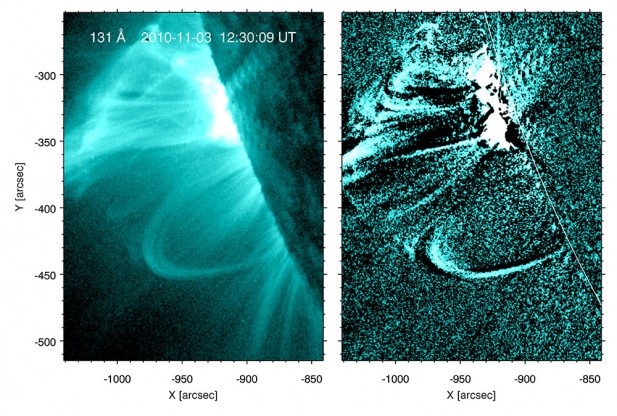
Scientists Study Coronal Loops To Gain Insight Into Solar Dynamics
Tuesday, July 2, 2013
|

John P. Mills, Ph.D. for redOrbit.com — Your Universe Online
Solar flares and the even more violent Coronal Mass Ejections (CMEs) are spectacular events, driving enormous amounts of energy and streams of charged particles into space. While researchers have had the opportunity to study these events for decades, we are still learning about what initiates these explosions.
Previous studies have revealed that twisted magnetic field lines within the solar structure will pierce the surface of the Sun. These coronal loops are filled with hot plasma, with temperatures exceeding a million degrees. As these structures evolve, oscillating over time, they can lead to dynamic solar events.
Recently, a team from the University of Glasgow studied four groups of coronal loops that rapidly collapsed on March 9th of last year. The result was a solar flare.
“This event is a great example of a simultaneous implosion and explosion,” said Paulo Simoes. “Our interpretation is that energy is transferred from the magnetic field to power the flare, leaving a pocket of reduced magnetic support that causes an implosion. The staggering between the loop contractions is caused by the time delay needed for the ‘information’ about the loss of support to travel outwards.”
The team found that the loop contractions were coincident with intense X-rays and microwaves that were emitted during the flare. Even during the contraction of the loops, three of the four continued to oscillate with measurable periods and phases. As the coronal loops collapsed, part of the magnetic field oscillated until a new equilibrium was reached. Researchers also noted the presence of ultraviolet radiation that fans out away from the source of the flare.
“This presents an intriguing picture of how magnetic energy is moved rapidly around the solar corona during a flare,” said Dr. Simoes.
In a complementary study at the University of Warwick, a team led by Rebecca White found the first evidence that the loop oscillations are driven by magnetic reconnection, a process that scientists have previously suspected was the driving mechanism for solar flares and CMEs.
“The structure and dynamics of the solar corona can be imaged in exquisite detail and over an unprecedented range of temperatures by SDO. Oscillating loops are a useful tool for probing conditions in the corona. This offers a unique opportunity to discover the tell-tale signatures of magnetic reconnection,” said Rebecca White.
Also using data from the Solar Dynamics Observatory (SDO), a CME in November of 2010 and a solar flare from May of 2012 were examined. The first event revealed a coronal loop emerge below a bubble of material that was eventually ejected during the CME. Furthermore, the CME was connected with the top of the coronal loop by a strand of magnetic field and plasma.
“The loop appears to twist about a fixed point along its length. Not only is the form of this oscillation highly unusual but the coronal loop has a temperature of between 9 and 11 million degrees – this is much hotter than most loops we see, which are generally between 1 and 3 million degrees. This extreme heat has been generated by the reconnection processes,” said White. “For the first time we can see a direct link between the reconnection process itself, causing the formation of the loop below the ejected bubble, and the oscillations of the loops.”
In the later study, the team found two adjacent loops were oscillating in opposite directions. This contradicts previous observations where the loops were caused to oscillate by the emerging flare, but always in the same direction.
“Again, this cannot be explained by a blast wave since this would push both loops in the same direction. We think that the oscillations here are a direct result of the flare reconnection process changing the structure of the corona between the loops and sucking them towards each. These observations demonstrate that loop oscillations are a valuable tool for studying 3D reconnection processes at work,” said White.